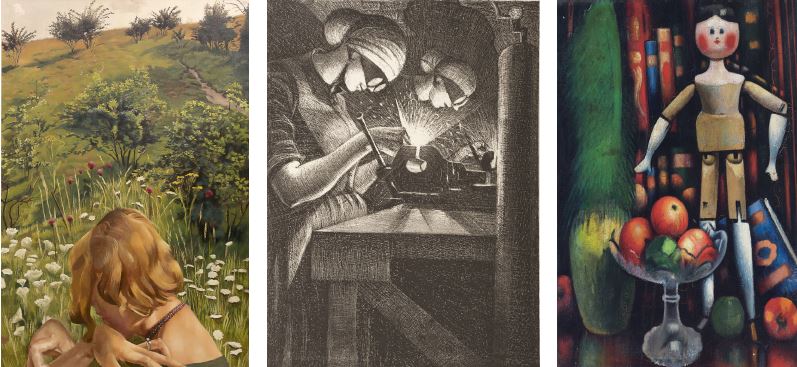NEW EXHIBITION SEEKS TO CONTEXTUALISE STANLEY SPENCER’S PLACE IN THE CANON OF MODERN BRITISH ART

David Bomberg, Henri Gaudier-Brzeska and Mark Gertlerare amongst the seventeen artists featured in Counterpoint – Stanley Spencer and his Contemporaries, a major exhibition that seeks to offer new perspectives on Spencer’s work and contextualise his place in the history of Modern British art, opening 28 April 2019.
The presentation, which will mark the 60th anniversary of the artist’s death, is comprised of thirty-nine works – twenty from the Stanley Spencer Gallery and nineteen spectacular loans from the Ingram Collection. The loans include works by many of the leading lights of twentieth century British art, as well as highly deserving pieces by less well-known figures such as Glyn Philpot and Dod Proctor. All help us to understand how Spencer’s work fits into the canon of Modern British art at the beginning of the 20th century.
Says the show’s curator, Amanda Bradley: Early twentieth century Britain saw the coming of age of a singular group of artists. Some shared the background of their arts training at the Slade School of Art. Others were less directly connected to each other, but through the lens of their collective ‘talents we experience seismic historic events (two world wars), and vast social and economic change. Each of the artists represented here experienced and portrayed this shared history with a particular vision and expression. The exhibition’s title – Counterpoint – reflects the complementary and diverse artistic talents across the works on show.
Counterpoint is Stanley Spencer Gallery’s first group exhibition for many years – hitherto it has only shown works by Spencer – and is divided into seven thematic strands: ‘The Slade’, ‘The Great War’, ‘Religion’, ‘Landscape’, ‘The Artist’s Muse’, ‘The Long Weekend’ and ‘World War II’.
‘The Slade’ features a lithograph made from Spencer’s self-portrait of 1913, captured when he was in his early twenties. Also included is Maternity, a bronze figure by Henri Gaudier-Brzeska, a self-portrait woodcut by Roger Fry, a Vorticist-inspired drawing, Bargee Family (1919-20), by David Bomberg and Mark Gertler’s The Doll(1914).
‘The Great War’ – Spencer initially served as a medical orderly at an army hospital in Bristol, but later became a combatant fighting in the Macedonia campaign – features four works including Wounded Being carried by Mules in Macedonia (1918-19), Pack Mules (1918-1919), along with a portrait, Albert Henry Seager (1915). On display with these is a 1918 portrait by Jacob Epstein, a lithograph by CRW Nevinson, Building Aircraft: Acetylene Welder (1917) and Eric Kennington’s Interior of an Adrian Hut (1917-1918).
Spencer famously used his beloved Cookham, the idyllic Berkshire village where he was born and lived for long periods of his adult life, as the backdrop for many of his religious paintings, witnessed here in The Last Supper(1920), St Veronica Unmasking Christ (1921), and the unfinished Christ Preaching at Cookham Regatta (1952-9).
‘Landscape’ features work by David Jones (Brockley in April, 1926) and John Craxton (Knowlton Church, 1941), and Spencer’s View from Cookham Bridge (1936) and The Mill, Durweston (1920). The artist’s troubled personal life is well-documented – he was famously lured away from a happy marriage by Patricia Preece – which is eluded to in ‘Artist Muse’. There are two depictions of Preece, Portrait of Patricia Preece (1920) and Patricia at Cockmarsh Hill (1935), to be shown alongside a painting by Dod Proctor, Golden Girl (c. 1930), and a Portrait of Henry Lamb’s lover, Ottoline Morrell (1910-11).
‘The Long Weekend’ captures the period between the first and second world wars. On the Beach (1934) and The Swimming Bath (1959), by Robert Duckworth Greenham and William Roberts respectively, show people diving into pools or sunbathing at the seaside. Roberts’s slightly sinister work is offset by Spencer’s Girls Returning From A Bathe (1936), in which two fully-clothed women carry inflatable life-rings that look like giant saveloys.
The final theme, ‘World War II’, features two drawings for Spencer’s Lithgows Shipyard paintings and reunites his lithograph, Burners, with that of Barnett Freedman: Fifteen-Inch Gun Turret HMS Repulse (1941), part of the same series commissioned by the National Gallery. Showing with these are Edward Burra’s 1942 painting, Ropes and Lorries, and a John Armstrong work in tempera entitled Civil Aviation (1941 – 1943).
Concludes Bradley: ‘Because of the singularity of his vision, and because he was never part of a school or movement, Spencer is seen by some as standing apart, so it is a great pleasure to be showing his works alongside his contemporaries.’
The exhibition ends on 3 November 2019.



